Mary Josephine
Harrington
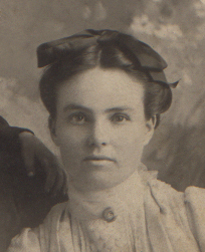 Mary Josephine Harrington, second child and first daughter
of Nancy Anne Branson and Peter Harrington, was born 2 September 1879 in Merced, Merced County, CA. Her
first name was seldom used. Aside from the 1880 census and her California Death Index entry, almost all
public records refer to her simply as Josephine (the surname evolving, of course, to match those of her
husbands). She consistently used Josephine and many relatives assumed it was her actual first name.
Mary Josephine Harrington, second child and first daughter
of Nancy Anne Branson and Peter Harrington, was born 2 September 1879 in Merced, Merced County, CA. Her
first name was seldom used. Aside from the 1880 census and her California Death Index entry, almost all
public records refer to her simply as Josephine (the surname evolving, of course, to match those of her
husbands). She consistently used Josephine and many relatives assumed it was her actual first name.
Josephine was raised in Merced. After (or shortly before) her father died in 1890, she
became one of the many residents of the boarding house operated jointly by her mother Nancy and her aunt
Mary Jane Branson Johnson. As the eldest girl in a group of eight children (herself, her five siblings,
and two of Mary Jane’s kids), a large amount of household responsibility no doubt fell on Josephine’s
shoulders at a young age. She was well motivated to obtain a less crowded home of her own, and managed
to do so at only eighteen years of age.
Josephine’s first husband was Charles Sweden McDonald. He was a son of Robert Seafield McDonald and Sarah
Ellen (“Ella”) Corlett, and had been born during the month of October, 1871 in Buffalo, Erie County,
NY. He had spent his early childhood in Buffalo, where his father worked as a blacksmith and subsequently
went to medical school. Charles’s grandfather, Sweden McDonald, had immigrated from Scotland to Canada
and had been a pioneer of Galt, Ontario Province. It was he who had changed the family name from MacDonald
to McDonald in order to blend in better with Irish neighbors. In the early 1880s,
after Robert had obtained his medical degree, the family had relocated to Ella Corlett McDonald’s hometown of
Oakfield, Genesee County, NY, not far east of Buffalo. Unfortunately, Robert had not enjoyed a long
career. He had passed away in the mid-1880s. The absence of a father may have been the spur that caused
Charles to venture far from his place of origin. He is believed to have come west because his uncle was
William McDonald, the widower of Josephine’s aunt, Phoebe Ann Branson. William McDonald was a beloved
paternal presence often at hand at the Merced boarding house, and when
his nephew arrived, the man would immediately have made him acquainted with his many nieces-by-marriage, of
whom Josephine was the closest to Charles’s age. Charles may even have been a lodger at the boarding
house for a period. The couple did not take long to decide they were right for each other. The
wedding took place 12 April 1898 in Merced, Rev. Father McNamara officiating. First son Robert Seafield
McDonald -- his grandfather’s namesake -- was born seven
months after the ceremony, the first great-grandchild of John Sevier Branson and Martha Jane Ousley to
arrive in the world. Two years later daughter Ruth A. McDonald was born, only to perish in infancy. The
couple’s final child was Charles Elton McDonald, better known as Elton, born in 1903.
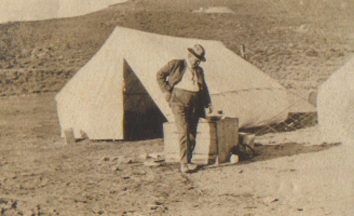 Like many men of Merced at the turn of the century, Charles
worked for Southern Pacific Railroad. During the early years of the marriage, his duties as a construction
supervisor and civil engineer took him afield. Josephine strived to arrange accommodations for herself and
the kids near his workplaces and often succeeded, though sometimes it was not always possible to keep the
family together. The full count of moves and the places lived in can only be guessed at. One of the first
sojourns was spent in Visalia, Tulare County, CA, where Robert was born in late 1898. That was followed by
a shift north. The 1900 census shows Charles living apart from Josephine and
Robert. He appears in County Supervisor’s District No. 1 in Contra Costa County, CA. His occupation is
described as clerk in railroad construction. He was in what appears to be a railway employee workers’
barracks shared with four other men. One of those men was John C. Harrington, Josephine’s brother, whose
occupation is given as railway timekeeper. Meanwhile Josephine, who is not enumerated in the census, is
assumed to have stayed with her kinfolk in Merced. Not only would that have been the logical haven, but
Merced is known to have been where she gave birth to Ruth in the final weeks of the year 1900. While Ruth
was still a newborn the family went south to Kern County, where they may well have lived in the very tents
you see in the photo at right, pitched near the spot where the small
town of Gosford now stands. (Charles is the heavyset man shown in the image.) Sadly, it may have been in
one of those very tents where Ruth died at the age of six months.
Like many men of Merced at the turn of the century, Charles
worked for Southern Pacific Railroad. During the early years of the marriage, his duties as a construction
supervisor and civil engineer took him afield. Josephine strived to arrange accommodations for herself and
the kids near his workplaces and often succeeded, though sometimes it was not always possible to keep the
family together. The full count of moves and the places lived in can only be guessed at. One of the first
sojourns was spent in Visalia, Tulare County, CA, where Robert was born in late 1898. That was followed by
a shift north. The 1900 census shows Charles living apart from Josephine and
Robert. He appears in County Supervisor’s District No. 1 in Contra Costa County, CA. His occupation is
described as clerk in railroad construction. He was in what appears to be a railway employee workers’
barracks shared with four other men. One of those men was John C. Harrington, Josephine’s brother, whose
occupation is given as railway timekeeper. Meanwhile Josephine, who is not enumerated in the census, is
assumed to have stayed with her kinfolk in Merced. Not only would that have been the logical haven, but
Merced is known to have been where she gave birth to Ruth in the final weeks of the year 1900. While Ruth
was still a newborn the family went south to Kern County, where they may well have lived in the very tents
you see in the photo at right, pitched near the spot where the small
town of Gosford now stands. (Charles is the heavyset man shown in the image.) Sadly, it may have been in
one of those very tents where Ruth died at the age of six months.
In 1903, Charles’s job situation changed. He was among those railroad men who were part of the inception
of Western Pacific. Ultimately this company’s main line served the western United States from Salt Lake
City to the San Francisco Bay Area. The creation of this line in the 1903 to 1918 time period broke the
stranglehold the big companies of Southern Pacific and Union Pacific had maintained over rail service in
the Far West. As an assistant civil engineer Charles was one of the men responsible for the establishment
of the line between Oakland and Sacramento. Later, in the 1910s, he would play a major role in the constructing
the masterpiece of the company’s infrastructure, the segment that ran through the Feather River Canyon. This
route, well north of those used by other companies, crossed the Sierra Nevada range at a much gentler grade,
permitting freight to be transported at lower cost, and the construction itself was affordable to the firm’s
investors due to ingenious surveying of the ideal right of way. Eldest son Robert would work with the Feather
River segment construction crews right after his graduation from high school in the mid-1910s.
As Charles’s position with Western Pacific evolved, the household was reestablished in Stockton, San
Joaquin County, CA. Stockton was a locale convenient to Charles’s responsibilities in the delta. The
family moved to the town no later than 1906, moving into a house at 16 N. Union Street. The residence was
ample enough that the McDonalds took in relatives on at least two occasions. Josephine’s teenaged first
cousin Inez Branson, daughter of Thomas Branson, became a student at Western School of Commerce in Stockton
and needed a place to stay during
the 1906-07 school term while working toward a teaching credential. Inez is the woman on the left in the
photo below, an image preserved in Josephine’s mementoes. A couple of years later the house was shared
with Clarence Johnson and his wife Lillian and their baby daughter Ruth. With Charles having to be gone
from the house so much, Josephine probably appreciated having other adults around.

This photograph was taken 19 May 1907 in front of the McDonald residence at 16 N. Union Street,
Stockton, CA. Apparently it commemorates a visit by friends Avis Albert King and his wife Myrta
Graham King and their young son William. Josephine wrote everyone’s first names on the back.
Identifying the King family took some time because she simply wrote “King” instead of Avis, perhaps
meaning that he was often known to friends by his last name. From left to right, the adults are: Inez
Branson, Mary Josephine Harrington McDonald, Myrta Graham King, Avis Albert King, Charles Sweden
McDonald. From left to right, the boys are: Charles Elton McDonald, Robert Seafield McDonald, and
William King. Another good impression of Josephine and Charles from the 1906-1910 time period can be
seen in the midst of the biography of Clarence Johnson. Click
here to go straight to that page.
By mid-1910, the Johnsons moved on to Manteca. Precisely how long the
McDonalds may have lingered in Stockton is not clear. They may have left at the same time as the
Johnsons. If so, it is possible they spent an interval in the Salt Lake City region, where the other end
of the rail line was being constructed. Photos show Charles and sons Robert and Elton at Corrine,
UT during the early 1910s, though it is possible they were only visiting. Perhaps further research will
resolve the question, but for now, it is clear Josephine and Charles and the kids were based in Stockton
in 1910 and then by
no later than 1914 had arrived in Oakland, Alameda County, CA. A photo album that belonged to Robert
includes images of freshman orientation at Oakland Polytechnic High School in 1914 -- presumably,
these are photos of Robert’s own school.
If Josephine ever felt any reticence to say good-by to her Merced roots, she dealt with it. It
wasn’t as if the option existed to truly go back home. The boarding house had become a thing of
the past years earlier, and by the 1910s only a tiny number of kinfolk were still dwelling in the
town. A kind of mass exodus had occurred. In approximately 1902, her mother and stepfather “Babe”
Napier had moved to San Joaquin County, and by 1905 or 1906 had acquired a farm east of the town of
Manteca. Within another couple of years, Josephine’s sisters Elsie, Eunice, and Irene had become based
on Manteca-area farms as well. That was a major reason why Clarence and Lillian moved to Manteca in
1910. Other relatives would do likewise over the next five years. For Josephine the story was different.
She was now a resident of the East Bay, and that is how it would remain for the rest of her life. Given the
railroad connections, this was entirely appropriate. The eastern side of the bay was a popular home base
for railroad men whether they worked for Western Pacific or Southern Pacific. Furthermore the regional
economy was booming, meaning Robert and Elton
would be well positioned to select from a number of career choices, or find decent interim positions while
deciding what they wanted to do long-term -- for example, when Robert took a job at the Alameda shipyards
as part of the war effort.
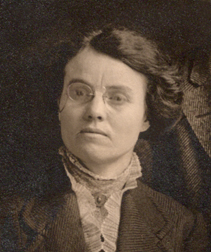 Robert’s draft card shows the family residing on Valdez
Street in Oakland. This may have been their
home from the time they arrived in the city years earlier. By that point -- late 1918 -- things were
settling down. The big push to complete the Feather River segment of the Western Pacific line had
taken place in 1917, with Robert helping out in the construction camps as an errand runner and
general assistant to his father. Robert now had a steady and serious girl friend, Vera Douglas. Josephine
and Charles were finally well positioned to obtain a “legacy” sort of home, and set themselves up for
the latter third of their lives. Thus, in June, 1919, the couple purchased a house at 1442 Morton Street
in Alameda. This home would
remain in the family for decades. The 1 January 1920 census shows the family in their new residence.
Charles is listed as a payroll clerk for Western Pacific -- finally a desk job to reward him for his
many years of work out in the boonies. Robert, though an adult, was still there, though he might by
then have spent a brief period as a bachelor on his own. In addition to the four family members the
household also included Vera Douglas, whom Robert was soon to marry.
Robert’s draft card shows the family residing on Valdez
Street in Oakland. This may have been their
home from the time they arrived in the city years earlier. By that point -- late 1918 -- things were
settling down. The big push to complete the Feather River segment of the Western Pacific line had
taken place in 1917, with Robert helping out in the construction camps as an errand runner and
general assistant to his father. Robert now had a steady and serious girl friend, Vera Douglas. Josephine
and Charles were finally well positioned to obtain a “legacy” sort of home, and set themselves up for
the latter third of their lives. Thus, in June, 1919, the couple purchased a house at 1442 Morton Street
in Alameda. This home would
remain in the family for decades. The 1 January 1920 census shows the family in their new residence.
Charles is listed as a payroll clerk for Western Pacific -- finally a desk job to reward him for his
many years of work out in the boonies. Robert, though an adult, was still there, though he might by
then have spent a brief period as a bachelor on his own. In addition to the four family members the
household also included Vera Douglas, whom Robert was soon to marry.
Just when the prospects for domestic stability seemed at
their all-time high, fate introduced a change of direction. Charles never got to enjoy the sweet “prime
of life” phase. Like all of the grandsons of Sweden McDonald except his younger brother Stephen Blaine
McDonald, Charles was a carrier of the gene that leads to hereditary haemochromatosis. That disease,
more commonly called iron overload, interferes with the body’s absorption of iron. While this can be
controlled through diet and other measures, the disease was not well understood in the early 20th Century
and Charles had little or no guidance to prevent the manifestation of symptoms, which can include such
negative health effects as liver failure, pancreas failure (causing diabetes), or heart failure -- or all
of these things. Charles’s case is
undoubtedly what caused him to be overweight even when he was a young man. Suddenly things came to a crisis
point, probably in the form of a heart attack. He died 22 February 1920.
Charles’s passing seems to have dimmed Josephine’s affection for the Morton Street house. While her name
remained on the deed for the rest of her life, she let Robert and Vera use it as their home. She no doubt
stayed there off-and-on over the next five years, but it is apparent she was often gone on extended visits
to her sisters and mother in Manteca. One lasting bit of evidence of her Manteca sojourns is that the
latter locale must have been where she met and got to know the man who became her second husband. He was
Daniel Webster Baysinger, a carpenter and contractor who had long lived in Manteca and who was
associated with Joshua and Emily Cowell, who were the parents-in-law of Josephine’s sister Elsie
Harrington Cowell. Joshua Cowell would ultimately be known as the “Father of Manteca” for his role in
establishing the community. Daniel Baysinger, by the end of his career there, was said to have built
nearly every commerical structure in town, along with many houses. Some of those jobs were done on behalf
of the Cowell family; for example, the four-bedroom residence of Joshua and Emily’s daughter Hattie and
son-in-law Maxie Mewborn, erected in 1914 and today regarded as one of the grand old houses of Manteca.
Daniel had even boarded with Joshua and Emily for a number of years, though he was no longer doing
so at the time he and Josephine were courting. Josephine’s mother may have had a hand in the matchmaking,
just as it was her influence that pointed Elsie toward her husband-to-be Otis Cowell back in 1906. If not,
it was probably Elsie’s doing.
In chosing Daniel, Josephine had once again elected to enter a bond with a man significantly older than
herself. Daniel, a son of Jacob Harrison Baysinger and Amanda Miller, had been born in 25 November 1864
in Kansas, probably in Labette County. The family had arrived in Labette County no more than a year or
two before Daniel’s birth, having left Breckenridge County, KY, where not only Daniel’s older siblings
but both parents had been born. (The move had perhaps been a case of avoiding being in the crosshairs of
the campaigns of the Civil War.) In Daniel’s early boyhood, Jacob Baysinger had been a farmer in Osage
Township in Labette County, then had become a carpenter in the small
town of Parsons. It was no doubt his father who taught Daniel the job skills he had made such thorough
use of during the decades before he and Josephine became an item.
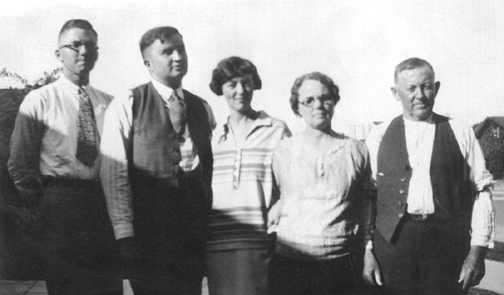
Josephine in the mid-to-late 1920s with her immediate family. From left to right, Charles Elton
McDonald, Robert Seafield McDonald, Vera K. Douglas, Mary Josephine Harrington McDonald Baysinger, and
Daniel Webster Baysinger.
Inasmuch as Daniel was nearly sixty and Josephine approaching forty-five when they were wed, no children
resulted from their union. The wedding took place 22 May 1924 in Alameda, officiated by H.V. Miller.
By that point in time, Daniel had found work as a contractor in Palo Alto, and had established a home
there on Hawthorne Street. This would be the couple’s initial place of residence. By no later than
1926, however, they made a new home at 949 Addision, where they
would remain into the mid-1930s. In 1934, family developments prompted a change. In the summer of that
year, Josephine’s daughter-in-law Tonia Utkin McDonald committed suicide, leaving Elton as a single father
of a six-year-old daughter. Elton, according to the dictates of his era, was expected to maintain a
full-time job. This position was across the bay in San Francisco, so he was not able to look in on his
daughter during the main part of each weekday. Despite Elton’s deeply parental nature, another caregiver
was needed. Josephine filled that role. It was best for all concerned that Josephine be a resident of
Alameda, so she and Daniel relocated to a fine house at 1535 St. Charles Street, back in the neighborhood
Josephine had once called home inasmuch as the place was only a short walk from 1442 Morton Street. For
most of the remainder of the 1930s, the house was shared with Elton and his little one, who endearingly
called her grandmother “Gongie.”
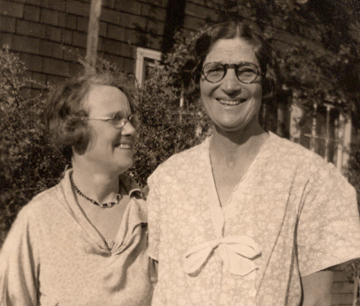 The remainder of the 1930s and the early 1940s were later
regarded by family members with great nostalgia.
They were good years. Josephine was able to be a help to her boys and was on hand not only to look after
her live-in grandchild, but also her other grandchildren -- Robert’s children with his second wife Loretta
Verschelden. Being in Alameda also put Josephine near her first cousin George Bertrand Johnson. Like Clarence
Johnson, George was almost a brother to Josephine -- perhaps even more so, in the sense that George had been
raised right in the boarding house with Josepine, whereas Clarence had become the adopted son of his aunt
Theresa Branson Moore and had resided in a separate home. George’s presence and his almost-daily involvement
in the life of the McDonald clan was a comfort to Josephine, particularly because Clarence Johnson had died
in 1932 and her biological brother John C. Harrington would pass away somewhat early as well. In the
summer of 1936, her sister Elsie, who had become a widow two years earlier, moved in with Josephine and
Daniel. (Josephine and Elsie are shown at left.) This made the house a little crowded until Elton and
his daughter moved on to their own place, but Josephine treasured having her sister there.
The remainder of the 1930s and the early 1940s were later
regarded by family members with great nostalgia.
They were good years. Josephine was able to be a help to her boys and was on hand not only to look after
her live-in grandchild, but also her other grandchildren -- Robert’s children with his second wife Loretta
Verschelden. Being in Alameda also put Josephine near her first cousin George Bertrand Johnson. Like Clarence
Johnson, George was almost a brother to Josephine -- perhaps even more so, in the sense that George had been
raised right in the boarding house with Josepine, whereas Clarence had become the adopted son of his aunt
Theresa Branson Moore and had resided in a separate home. George’s presence and his almost-daily involvement
in the life of the McDonald clan was a comfort to Josephine, particularly because Clarence Johnson had died
in 1932 and her biological brother John C. Harrington would pass away somewhat early as well. In the
summer of 1936, her sister Elsie, who had become a widow two years earlier, moved in with Josephine and
Daniel. (Josephine and Elsie are shown at left.) This made the house a little crowded until Elton and
his daughter moved on to their own place, but Josephine treasured having her sister there.
“Good years” refers to the perspective of the younger generations. For Josephine, the goodness was marred
by a number of emotionally wrenching losses. The latter half of 1940 was particularly severe in that
regard. Her brother-in-law Claude Salmon died on the first of August, her sister Elsie two days
later, and brother John two months after that. That same year, Daniel Baysinger’s
health entered its final decline. He hung on for two years, passing away at home 4 November 1942.
Josephine chose not to marry a third time. Though the period of Daniel’s decline, and on into 1943
and possibly into 1944, she had the companionship of her sister Irene, who had moved in right after
being widowed, in effect taking Elsie’s place at 1535 St. Charles Street.
Though her granddaughter was no longer literally under the same roof, Josephine finished doing her part
to raise the youngster to adulthood. It wasn’t long after the girl had left the Bay Area to attend UCLA
that Josephine decided there was no point in maintaining an entire large house just
for her personal needs, so she moved out of 1535 St. Charles into an apartment in Oakland. This was her
final change of residence.
Throughout her life Josephine cherished her family bonds. Often she played the role of the big sister,
lending her support. She opened up her home time and again when her kinfolk were in need. Already
mentioned above are the occasions when Inez Branson, Clarence Johnson and family, Elton and his
daughter, and then widowed Elsie and widowed Irene were sheltered by Josephine. This was on top of
other, briefer instances of hospitality such as when her sister Eunice’s husband Winfred Converse
had to be hospitalized in San Mateo in 1929. Josephine and Daniel sheltered Winfred and Eunice in their
Palo Alto home while he recuperated. Finally at the end of her life, Josephine welcomed one
last relative -- her youngest sister, Nina, who showed up to handle the cooking and
housekeeping while Josephine was succumbing to colon cancer. The disease claimed Josephine’s life 28
June 1955.
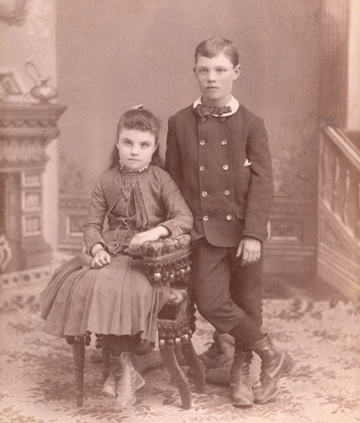
Josephine and her brother Jack in the 1880s in Merced. Photo taken at Edwards
Studio.
Children of Josephine
Harrington with Charles Sweden McDonald
Robert Seafield
McDonald
Ruth A.
McDonald
Charles Elton
McDonald
To go back one generation, click here. To return
to the Branson/Ousley Family main page, click here.
 Mary Josephine Harrington, second child and first daughter
of Nancy Anne Branson and Peter Harrington, was born 2 September 1879 in Merced, Merced County, CA. Her
first name was seldom used. Aside from the 1880 census and her California Death Index entry, almost all
public records refer to her simply as Josephine (the surname evolving, of course, to match those of her
husbands). She consistently used Josephine and many relatives assumed it was her actual first name.
Mary Josephine Harrington, second child and first daughter
of Nancy Anne Branson and Peter Harrington, was born 2 September 1879 in Merced, Merced County, CA. Her
first name was seldom used. Aside from the 1880 census and her California Death Index entry, almost all
public records refer to her simply as Josephine (the surname evolving, of course, to match those of her
husbands). She consistently used Josephine and many relatives assumed it was her actual first name. Like many men of Merced at the turn of the century, Charles
worked for Southern Pacific Railroad. During the early years of the marriage, his duties as a construction
supervisor and civil engineer took him afield. Josephine strived to arrange accommodations for herself and
the kids near his workplaces and often succeeded, though sometimes it was not always possible to keep the
family together. The full count of moves and the places lived in can only be guessed at. One of the first
sojourns was spent in Visalia, Tulare County, CA, where Robert was born in late 1898. That was followed by
a shift north. The 1900 census shows Charles living apart from Josephine and
Robert. He appears in County Supervisor’s District No. 1 in Contra Costa County, CA. His occupation is
described as clerk in railroad construction. He was in what appears to be a railway employee workers’
barracks shared with four other men. One of those men was John C. Harrington, Josephine’s brother, whose
occupation is given as railway timekeeper. Meanwhile Josephine, who is not enumerated in the census, is
assumed to have stayed with her kinfolk in Merced. Not only would that have been the logical haven, but
Merced is known to have been where she gave birth to Ruth in the final weeks of the year 1900. While Ruth
was still a newborn the family went south to Kern County, where they may well have lived in the very tents
you see in the photo at right, pitched near the spot where the small
town of Gosford now stands. (Charles is the heavyset man shown in the image.) Sadly, it may have been in
one of those very tents where Ruth died at the age of six months.
Like many men of Merced at the turn of the century, Charles
worked for Southern Pacific Railroad. During the early years of the marriage, his duties as a construction
supervisor and civil engineer took him afield. Josephine strived to arrange accommodations for herself and
the kids near his workplaces and often succeeded, though sometimes it was not always possible to keep the
family together. The full count of moves and the places lived in can only be guessed at. One of the first
sojourns was spent in Visalia, Tulare County, CA, where Robert was born in late 1898. That was followed by
a shift north. The 1900 census shows Charles living apart from Josephine and
Robert. He appears in County Supervisor’s District No. 1 in Contra Costa County, CA. His occupation is
described as clerk in railroad construction. He was in what appears to be a railway employee workers’
barracks shared with four other men. One of those men was John C. Harrington, Josephine’s brother, whose
occupation is given as railway timekeeper. Meanwhile Josephine, who is not enumerated in the census, is
assumed to have stayed with her kinfolk in Merced. Not only would that have been the logical haven, but
Merced is known to have been where she gave birth to Ruth in the final weeks of the year 1900. While Ruth
was still a newborn the family went south to Kern County, where they may well have lived in the very tents
you see in the photo at right, pitched near the spot where the small
town of Gosford now stands. (Charles is the heavyset man shown in the image.) Sadly, it may have been in
one of those very tents where Ruth died at the age of six months.
 Robert’s draft card shows the family residing on Valdez
Street in Oakland. This may have been their
home from the time they arrived in the city years earlier. By that point -- late 1918 -- things were
settling down. The big push to complete the Feather River segment of the Western Pacific line had
taken place in 1917, with Robert helping out in the construction camps as an errand runner and
general assistant to his father. Robert now had a steady and serious girl friend, Vera Douglas. Josephine
and Charles were finally well positioned to obtain a “legacy” sort of home, and set themselves up for
the latter third of their lives. Thus, in June, 1919, the couple purchased a house at 1442 Morton Street
in Alameda. This home would
remain in the family for decades. The 1 January 1920 census shows the family in their new residence.
Charles is listed as a payroll clerk for Western Pacific -- finally a desk job to reward him for his
many years of work out in the boonies. Robert, though an adult, was still there, though he might by
then have spent a brief period as a bachelor on his own. In addition to the four family members the
household also included Vera Douglas, whom Robert was soon to marry.
Robert’s draft card shows the family residing on Valdez
Street in Oakland. This may have been their
home from the time they arrived in the city years earlier. By that point -- late 1918 -- things were
settling down. The big push to complete the Feather River segment of the Western Pacific line had
taken place in 1917, with Robert helping out in the construction camps as an errand runner and
general assistant to his father. Robert now had a steady and serious girl friend, Vera Douglas. Josephine
and Charles were finally well positioned to obtain a “legacy” sort of home, and set themselves up for
the latter third of their lives. Thus, in June, 1919, the couple purchased a house at 1442 Morton Street
in Alameda. This home would
remain in the family for decades. The 1 January 1920 census shows the family in their new residence.
Charles is listed as a payroll clerk for Western Pacific -- finally a desk job to reward him for his
many years of work out in the boonies. Robert, though an adult, was still there, though he might by
then have spent a brief period as a bachelor on his own. In addition to the four family members the
household also included Vera Douglas, whom Robert was soon to marry.
 The remainder of the 1930s and the early 1940s were later
regarded by family members with great nostalgia.
They were good years. Josephine was able to be a help to her boys and was on hand not only to look after
her live-in grandchild, but also her other grandchildren -- Robert’s children with his second wife Loretta
Verschelden. Being in Alameda also put Josephine near her first cousin George Bertrand Johnson. Like Clarence
Johnson, George was almost a brother to Josephine -- perhaps even more so, in the sense that George had been
raised right in the boarding house with Josepine, whereas Clarence had become the adopted son of his aunt
Theresa Branson Moore and had resided in a separate home. George’s presence and his almost-daily involvement
in the life of the McDonald clan was a comfort to Josephine, particularly because Clarence Johnson had died
in 1932 and her biological brother John C. Harrington would pass away somewhat early as well. In the
summer of 1936, her sister Elsie, who had become a widow two years earlier, moved in with Josephine and
Daniel. (Josephine and Elsie are shown at left.) This made the house a little crowded until Elton and
his daughter moved on to their own place, but Josephine treasured having her sister there.
The remainder of the 1930s and the early 1940s were later
regarded by family members with great nostalgia.
They were good years. Josephine was able to be a help to her boys and was on hand not only to look after
her live-in grandchild, but also her other grandchildren -- Robert’s children with his second wife Loretta
Verschelden. Being in Alameda also put Josephine near her first cousin George Bertrand Johnson. Like Clarence
Johnson, George was almost a brother to Josephine -- perhaps even more so, in the sense that George had been
raised right in the boarding house with Josepine, whereas Clarence had become the adopted son of his aunt
Theresa Branson Moore and had resided in a separate home. George’s presence and his almost-daily involvement
in the life of the McDonald clan was a comfort to Josephine, particularly because Clarence Johnson had died
in 1932 and her biological brother John C. Harrington would pass away somewhat early as well. In the
summer of 1936, her sister Elsie, who had become a widow two years earlier, moved in with Josephine and
Daniel. (Josephine and Elsie are shown at left.) This made the house a little crowded until Elton and
his daughter moved on to their own place, but Josephine treasured having her sister there.